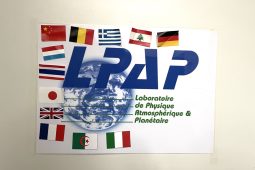PPARC セミナー (2024/11/01)

PPARC セミナー (2024/11/01)
(1) Natsuko Matsushita
[Title]
Plasma parameters at Europa’s orbit estimated from the Hisaki observation
[Abstract]
Europa (9.4 RJ from Jupiter) has a tenuous molecular oxygen atmosphere, produced by magnetospheric plasma sputtering on its surface. To improve our understanding of the production and loss of the atmosphere, the density and temperature of the magnetospheric plasma around the satellite must be known. However, plasma observations at Europa’s orbit are still limited. In this study, we used JAXA’s Hisaki data from February to May 2015 to estimate the plasma parameters at Europa’s orbit.
An ultraviolet spectrograph (EXCEED) aboard Hisaki measured the sulfur and oxygen ion emission lines in the extreme ultraviolet (EUV) wavelength range (55-145 nm). The Jovian magnetosphere is filled with plasmas from satellite Io (5.9 RJ). The torus emission intensity peaks around Io’s orbit and decays with increasing radial distance from the planet. At Europa’s orbit, the brightness was so weak that contaminations from the terrestrial radiation belt and foreground emissions (geocorona) were carefully removed, and the spectrograph data were integrated for over 2 months (over 15,000 min). The emission intensity is a product of the ion density and natural transition probability along the line of sight. The torus ions are excited by electron impact so that the ion density of a certain energy level depends on the density and temperature of the electrons. We used the CHIANTI atomic database to find the best-fit plasma parameters of the observed spectrum by minimizing the chi-square, a method known as plasma diagnosis.
The sulfur and oxygen ion emission lines were identified at Europa’s orbit. The brightest line was 1.6 Rayleigh at 68.0nm (S++), approximately 3% of that at Io’s orbit. The emission lines with S/N < 2 were excluded from plasma diagnosis. We assumed that the plasma in the torus (S+, S++, S+++, O+, O++, H+, and e-) was quasi-charge-neutral and O++/ O+ was fixed at 0.1. The temperature of hot electrons was fixed to 300 eV. From plasma diagnosis, we found that the electron density was 233±24 /cc, the core electron temperature was 6.9±1.7 eV, and the hot electron fraction was 42±6 % at Europa’s orbit. In this seminar, we will report on our progress.
(2) Fuminori Tsuchiya
[Title]
Plasma mass loading process in the Jovian magnetosphere
[Abstract]
Mass loading is one of fundamental plasma processes that occur around planetary space environment. The mass loading occurs through ionization of neutral gas in the magnetized plasma and/or mixture of plasma population from one region to another. In the Jovian magnetosphere, the mass loadings due to Io-genic gasses have important role in extracting energy from planetary rotation to plasma heating through magnetosphere-ionosphere coupling.The mass loadings have three kinds of form: (1) Ionospheric escape (2) Ion pickup, and (3) radial plasma transport. The first two are related to moon-plasma interactions and the third is related to aurora process in the rotating magnetosphere. In this talk, we introduce mass loading and M-I coupling processes in the Jovian magnetosphere and review current understandings and discuss how remote-sensing with UV, optical, and radio wavelength contribute these topics.




